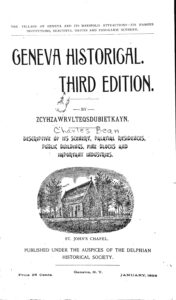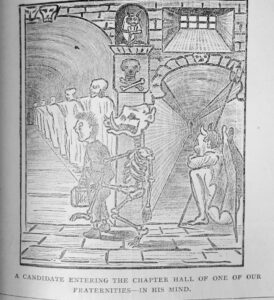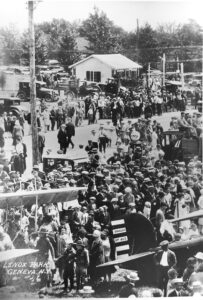Was Charles Bean a Conman, Part 2?
By Becky Chapin, Archivist
Continuing with the mysteries surrounding Charles Bean…
The Knights of Cyprus are also connected to a memorial to French actress Sarah Bernhardt which Bean erected on his property in Prattsburgh. The monument reads:
To Madame Sarah Bernhardt, the greatest actress in the world, whose lyric fire and divine voice gave more intense and supreme life to the poets. In found admiration is built this rugged memorial, by the Knights of Cyprus and Devoted Friends – 1845-1923 – Romance Holds open the door to Eternal Spring.

1896 Geneva Historical booklet published by Charles Bean (his name in code), claims to be published under the auspices of the Delphian Historical Society
Charles also seemed very enamored with the actress, writing over 30 letters to the Prattsburgh Advertiser addressed to her. Whether she saw the letters or not, the Knights of Cyprus seems to have existed only to Charles. Though he is credited with the first monument to the actress in the United States.
Charles also started Bean’s Station in Prattsburgh which was near the Kanona and Prattsburgh Railway. This is where he erected the Bernhardt memorial in addition to the American Soldiers and Sailors Memorial Gallery, which is said to have been built by the Delphian Historical Society of Geneva. For this organization, we have nothing on record which is not linked to Charles, so the purpose or chartered existence is unknown. His last monument in Prattsburgh was the Tablet of 1868 which was a commemoration to The Indian Oak; Charles claims it was connected to “Indian Councils” in the area, but its exact memorialization and present location of the tablet is not known.
Locally, Charles began Lenox Park as a housing development between the head of Washington and Hamilton Streets on his 52 acres, which included his own home at the corner of Pre-Emption and Hamilton. Dr. Spengler was his neighbor here and his home was included in the promotional booklets. Bean started around 1914 and by 1927 there were eleven houses, twelve garages built, with more lots on Reed Street, and two farms. The development doesn’t exist anymore, but the name continued with Lenox Ave/Road., Lenox Park Woodworking Co. (1940s-1960s) and Lenox Park Custom Kitchens (1970s).
Perhaps the most damning evidence against Charles is that of a relative through his mother, Frank Rupert. Frank was a frequent visitor of the Bean household and while he didn’t like to “debunk” Charles, knew there were some inconsistences with his claims. This is especially true of the Lafayette Tree. Charles Sr. talked of this tree often, for it was great in size, but it was never referred to as the Lafayette Tree until after 1890 and, according to Frank, it was only called that by Charles Jr.

1945 letter from Dr. Spengler to City Historian Malcolm Johnston refuting claims that he allowed Bean to use his name as a reference in regard to a marker for a place Bean calls Sa-Go-Yet-Ha
The 1876 History of Ontario County makes no mention of a stop other than at Geneva Hotel (in Pulteney Park) and the 1911 version claims the procession stopped briefly at the intersection for a signal gun to announce the arrival before the carriages proceeded on to the Park. Claims that General Lafayette stopped under this tree have been researched by Malcolm Johnston in addition to a former archivist here, Eleanore Clise. In the end, measurements of the tree to calculate its growth and following the General’s journey from Canandaigua to Geneva led the two historians to the conclusion that Lafayette bypassed this intersection for Pulteney Park which was the center of Geneva at the time.
Charles’ history of the visit and his subsequent publication of the same included assertions that the carriage he had at the Elmwood Priory Museum had been the one Lafayette used while in Geneva. Proof of this is hard to find but given that Charles was considered a reputable man in Geneva, folks believed him.
Frank also recalled Charles starting a local boys society, the Delphians, which he had been roped into but had quickly dropped out of, in addition to others which were “largely created out of [Charles’] mind.” Though Frank was adamant that he did “not wish to convey the impression that everything [Charles] wrote or did was illogical or untrue…perhaps he thought first [the stories] ought to be true, and then that they were facts.”
Frank attributed the odd things Charles did to his childhood, saying that Charles Sr. was very arbitrary, and that Charles’ desires and plans were thwarted many times by his father. Though he gives one example of this, Frank is not very clear about the relationship between father and son. It could be that Charles was not able to express himself during childhood and thus as an adult, any whim that he wanted to fulfill, he did.

An odd illustration from an 1896 Charles Bean publication showing a ‘candidate entering the chapter hall of one of our fraternities- in his mind’
Charles was published in all manner of places including legal journals and fraternity publications. He also self-published the Delphian Record through the Genesee Historical Federation (though this also seems to be a Bean original) and then several booklets related to history and Geneva including “Four Centennials,” “Historic Homesteads in Geneva,” “The Law of Fraternities and Societies,” “Orations and Addresses on Various Occasions,” “Geneva Historical,” “The SAR and the Sesquicentennial,” and more. His publications included his own “Reminiscences” which went through at least four editions.
Charles never married and died with no children to pass on his biography. We’ll probably never be able to confirm one way or another about Charles’ schools and societies, though other historians have debunked at least the Lafayette Tree story.


Very interesting history of Charles Bean. An interesting fellow and certainly part of Geneva’s history
Charles Bean was quite a character and certainly part of Geneva’s history. Prior to reading this, I had not known about all of his activities. The actual facts virus local belief about the LaFayette tree are interesting. Is there any factual information about the LaFayette Carriage owned by Historic Geneva?
Great question. The loan form (prior to our permanent acquisition) for the carriage says that it was originally the property of Major Rees, who was the son-in-law of William DeZeng. DeZeng is said to have been the one who provided the change of carriage for Lafayette en route to Canandaigua. The form also says it is a “Brewster coach reputed to be the coach General LaFayette rode from Geneva to Utica.”
Now how the carriage got back from Utica to Geneva, possibly into the hands of Bean, and then to the person who we acquired it from, if it is the same coach, I don’t have an answer to. All mysteries from our history that may never be solved.